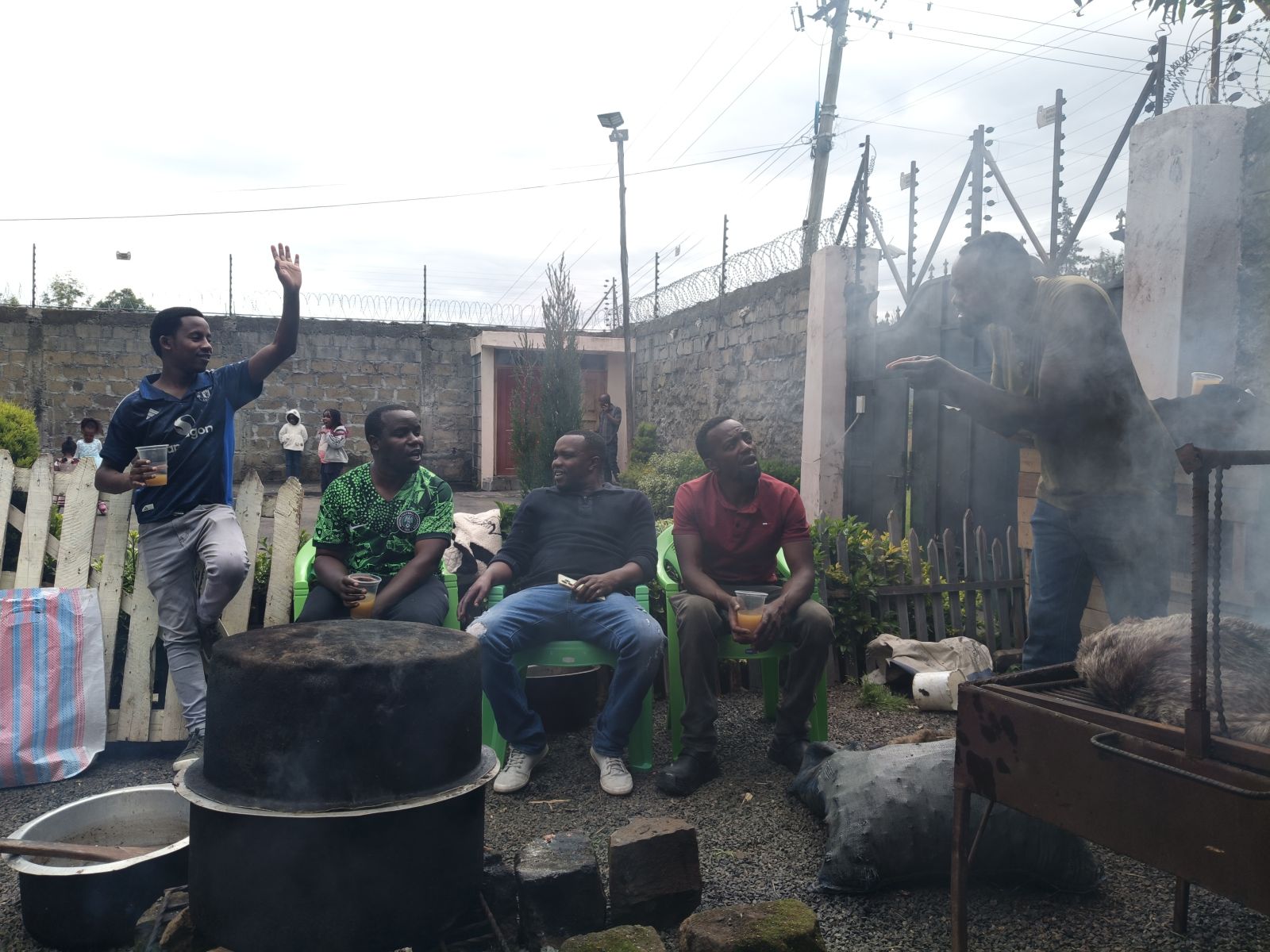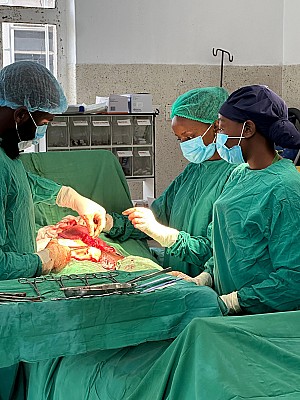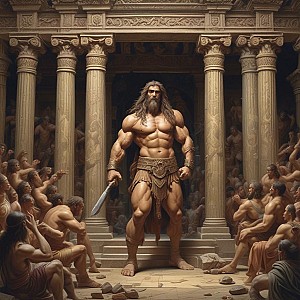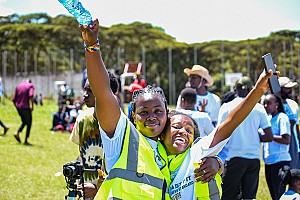
The Original Gender Reveal
Dr. James Muchiri , Kenya Nov 11, 2025
(Dedicated to the little warriors whose cry called us to ululate once more.)
We recently gathered in a friend’s house for one of those beautiful men’s moments — laughter, stories, and that quiet pride that fills the air when one of us becomes a father.
There was music, warmth, and, of course, muratina — that sacred nectar that turns ordinary talk into the kind of wisdom that only makes sense when the gourd has gone halfway down.
And somewhere between the laughter and the sip, it struck me — how beautiful the original gender reveal used to be.
Before the Balloons and the Powder
Today, gender reveals are an explosion of pink and blue. Cakes hide secrets, balloons burst into confetti, and someone always catches it all on camera. It’s fun, dramatic, even spectacular.
But before the colors, before the cameras and countdowns, our people had their own way.
They didn’t use balloons — they used breath.
They didn’t need fireworks — they had voices.
When a child was born, the community didn’t wait for a post — they listened.
If you heard four ululations, a girl had arrived.
If you heard five, a boy had been born.
But those ululations — ngemi — were not just about gender.
They were blessings sung through rhythm, virtues spoken in sound.
Four for the Girl
The girl’s four ululations, ngemi inya cia kairitu, formed a complete circle — a song of balance.
Each sound carried a virtue:
-
Uthamaki – Leadership: The ability to govern oneself and others with fairness and grace.
-
Ugo – Healing: The power to mend — to restore harmony in body, spirit, and community.
-
Urathi – Prophetic Insight: The divine ability to see beyond the visible — to discern seasons and speak truth before it unfolds.
-
Utonga – Wealth: Abundance of spirit and substance — the capacity to create, sustain, and share life.
The four ululations formed the full measure of inner strength — completeness, balance, and harmony.
Five for the Boy
The boy’s ngemi ithano cia kahii carried the same four virtues, but added a fifth — the one that sent him beyond the walls of home.
-
Ucamba – Bravery: Courage, endurance, and the will to defend what is right and true.
That fifth ululation was the outward call — to protect, to explore, to build, and to extend the legacy.
To the Little Warriors
And so, to the little warriors — within and beyond the Global Fast Fit circle — whose coming stirred our hearts:
Go forth, be a Prophet — bring light to your generation.
Go forth, be a King — govern with fairness and humility.
Go forth, be a Healer — mend what is broken in body and spirit.
Go forth, be a Wise Man — preserve harmony through understanding.
Go forth, be a Warrior — stand firm, protect, and lead with courage.
Five ululations were sounded for you — not just to announce your birth, but to proclaim your destiny.
The Beauty of the Old Ways
When I think of today’s gender reveals — the confetti, the colored smoke, the cheers — I smile. They’re joyous, yes, but they only reveal what the child is.
Our ancestors revealed who the child was meant to become.
They didn’t say, “It’s a boy” or “It’s a girl.”
They said, Here comes one who will lead, think wisely, see truly, prosper deeply, and stand bravely.
That was the original gender reveal — not of color, but of character.
And as for the muratina — that story deserves its own day.
I’ll tell you about it next time.

Gratitude
Dr. James Muchiri , Kenya Oct 06, 2025 1
Someone asked me the other day what my most valued trait is. Without hesitation, I said gratitude. That answer wasn’t born on a poster or inside a self-help book; it came out of a season that felt like a long, badly told joke.
I was a medical superintendent with an impressive title but no salary. For twelve months I worked without pay because I’d found myself on the wrong side of a tumbocratic county administration — and apparently, I needed to be “taught some manners.” My wallet had a Do Not Resuscitate order, yet my phone still lit up with wedding, funeral, and graduation committee requests. They weren’t bad people or greedy groups; those committees were part of the fabric of the community. It was only the timing that was off — their optimism about my contribution collided head-on with my empty bank account. I’d laugh when the messages came in because there was nothing they could extract from me. On their spreadsheets, my contribution must have read “thoughts and prayers.” That was my dark comedy channel at the time, and somehow it kept me sane.
Looking back now, I can see what was happening. My psychiatry teacher, Dr. Atwoli, used to tell us that depression is when life literally loses its colour and turns black and white. At the time I didn’t realise that was exactly what I was slipping into. It didn’t happen suddenly; it was gradual. Days that had once felt normal became dull. Food tasted flat. Music turned into noise. I still went to work, still signed charts, still cracked the odd joke — but I wasn’t really there.
It’s very much like the old frog fable: if you put a frog in boiling water it jumps straight out. But if you put it in cool water and slowly heat it up, it stays until it’s cooked because it doesn’t notice the danger. Depression works the same way. The “water” warms so gently you hardly notice. You just keep functioning while losing more and more of yourself. Sometimes you get out early. Other times you get out just in time. Looking back, that was me — still doing my job, still appearing “fine” on the outside, but quietly shrinking inside without realising it.
To cope, I withdrew. Isolation became my shield. The weight crept on and I slowly lost touch with who I was. My world shrank to work and walls. Solitude is tricky: at first it feels like safety, a quiet place where no one can demand anything from you. But over time it starts to bend you. With no outside voices, you lose perspective; you start replaying the same thoughts over and over until they harden into truths. Days blur into each other. Small problems feel huge. Your confidence shrinks because there’s no feedback except your own self-criticism. Yet there’s another side to it too. In the middle of all that stillness, once the noise dies down, uncomfortable truths get loud. You start to see patterns — in yourself, in others, in your environment — that you were too busy to notice before. Solitude can damage you if you stay in it too long, but it can also act like a mirror if you use it carefully. That’s what happened to me. My brain, which had felt dulled for months, started to feel like a tool again — rusty, yes, but still capable of being sharpened if I could just start using it differently.
One morning, I made a decision: “I must be more generous.” I had no money to give, but I still had knowledge. So I posted a simple WhatsApp status: “Free health consultations.”
The sheer volume of calls that streamed in was unbelievable. Each story was a rollercoaster — some heartbreaking, some hilarious, some unexpectedly beautiful. By evening I was tired in a clean way — the kind of fatigue that feels earned. And it hit me: even at my “rock bottom,” there were people living beneath it. That’s when I made the second resolution: be more grateful.
I kept going, then scaled to once a week before compassion burnout could sneak in wearing a friendly face. The strange alchemy of giving took hold: I offered what I knew, and it returned as something I had forgotten — relevance, connection, the sensation of being placed correctly on the map. Gratitude changed my posture. It didn’t fix the arrears; it fixed my angle toward the light.
At around that time, I reconnected with John Groom — the founder of Global Fast Fit. John is young for his age, a bundle of bright contradictions: methodical yet with a streak of stubbornness, a perfectionist, stylish, intelligent, relentless. He’s blunt enough to spare you confusion, precise enough to save you time. He dresses like calendars are watching and speaks with the tensile clarity of someone who has argued with first principles and won. He could take an ordinary conversation and turn it into a strategy session, then pivot and make you laugh in the same breath.
Years earlier, while I was still on campus, he had given me a job. That moment felt like a direct payoff from my childhood. As a young boy my father and I would sit with Brighter Grammar books, line by line. He emphasised the importance of good communication and clarity of thought, even when I was barely tall enough to see over the table. Those sessions built habits that later helped me write, speak and present myself — and those same skills opened the door to that first job with John Groom.
I looked up to John — not in the worshipful way that melts accountability, but in the respectful way that sharpens it. He travelled widely, lived boldly, and carried himself as though life itself was a canvas to be painted on his terms. Being around him made you want to step into a bigger version of yourself.
The journey with him has been transformative, not because it erased my struggles, but because it reframed them and showed me what could be built from them.
I’m exercising more. I’m learning table tennis. I’m working in a challenging but stimulating role as a medical consultant and regional manager for Global Fast Fit. I’m eating healthier. These small changes are building a very different daily rhythm from the one I had at rock bottom. They’re not dramatic, but they’re steady, and together they’re giving me back energy, confidence and purpose.
I’m still human. Some mornings I’m trying to be a functional adult and forgetting how. Some afternoons old habits win. But more often the direction is forward. The work is making sense. The coat is lighter. Becoming the Doctor of Free isn’t draining me; it’s giving me back purpose.
I’m still recommending rest, water, movement and a short list of medicines. But I’m also quietly prescribing the things saving me: clarity, gratitude and usefulness. They’re free, non-addictive and the refills are unlimited.
The brain is remarkable. It can break in complicated ways, but it can also repair itself while still working. That’s the gift I’m learning to appreciate. Mine isn’t perfect, but it’s sharper now and it’s remembering what it’s for.
Have a gratitude-filled October! Won’t you?

Holy Heavyweights
Dr. James Muchiri , Kenya May 07, 2025
Imagine a contest where the Bible’s strongest, fastest, and most enduring heroes compete head-to-head in a modern GFF Challenge: 30 push-ups, 30 squats, 30 leg lifts, and a 500-meter run. Using current world record exercise speeds and legendary (or plausible) animal speeds for the run, here’s how these iconic figures might compare.
Samson; Judge and Nazirite Strongman; 1:20 (Estimated)
Samson’s legendary strength is unmatched in scripture—tearing apart a lion, carrying city gates, and defeating armies single-handedly. While the Bible doesn’t describe his running speed, his explosive power and stamina would be off the charts. If Samson could perform each exercise in just 10 seconds and run 500 meters in 20 seconds—reflecting his miraculous abilities—he would finish the GFF challenge in approximately 1 minute and 20 seconds, likely the fastest among mortals.
Asahel; Young Warrior; 1:31
Asahel is remembered for being “swift as a gazelle,” a title taken literally here. Using a gazelle’s sprint speed for the 500-meter run (22.5 seconds) and world record times for the exercises, Asahel’s total GFF score would be 1 minute and 31 seconds, putting him among the speediest men of the Bible.
David; Young Shepherd/Warrior; 1:31
David, famed for his agility and strength—able to take on lions, bears, and giants—was compared to a deer for his speed. With a deer’s top speed for the run and elite times for the exercises, David would also complete the GFF challenge in 1 minute and 31 seconds, tying Asahel and proving his legendary athleticism.
Goliath; Veteran Philistine Champion; 2:00 (Estimated)
Goliath was described as a giant, towering over his opponents and feared for his raw power. His massive size likely gave him immense strength but limited his speed and agility. If he could complete the exercises in 20 seconds each and run 500 meters in 60 seconds—a fast time for someone of his build—his GFF score would be about 2 minutes flat, showing overwhelming power but not quite matching the swiftest.
Jacob; Middle-aged Patriarch and Angel-Wrestler; 0:45 (During the Feat), 8:43 (After)
Jacob performed one of the Bible’s most extraordinary feats by wrestling an angel through the entire night, a contest that no ordinary human could survive, let alone endure. In that miraculous moment, Jacob’s strength, endurance, and resolve would have soared to superhuman levels—if channeled into the GFF challenge, he could have completed all exercises and the run in a staggering 45 seconds, outpacing even the fastest mortals by a wide margin. However, the cost of this divine encounter was a dislocated hip, and after the struggle, Jacob’s physical abilities were drastically reduced; his post-fight GFF score would plummet to 8 minutes and 43 seconds, showing both the peak of his miraculous potential and the lasting impact of wrestling with the divine.
Saul; Grown King; 1:45
Saul, described as “swifter than eagles,” was tall, strong, and a formidable leader in battle. Matching an eagle’s flying speed for his 500-meter run (36 seconds) and using elite exercise times, Saul would complete the GFF challenge in 1 minute and 45 seconds, earning a place among the biblical elite.
Jonathan; Young Prince; 1:45
Jonathan, Saul’s son, was also praised for his speed and courage, often fighting at the front lines. With the same eagle comparison and athletic ability, Jonathan would match his father’s GFF score of 1 minute and 45 seconds, proving himself one of Israel’s finest warriors.
Caleb; Elderly Veteran (Age 85); 2:30
Caleb, at 85 years old, boldly claimed the hill country and drove out giants from Hebron. Even in old age, his faith and vigor were legendary. If we give him a strong but realistic veteran’s time—85 seconds for the 500-meter run and just above world record speeds for the exercises—Caleb would score about 2 minutes and 30 seconds. His performance would be remarkable for any age, and truly extraordinary for a man in his ninth decade.
These scores show that the Bible’s legendary figures, if placed in a modern fitness challenge, would still stand out for their unique strengths—whether speed, power, endurance, or sheer determination. Some, like Jacob, would even brush the edge of the miraculous.

Why I love my job as a General manager & medical consultant at Global Fast Fit.
Dr. James Muchiri , Kenya Sep 26, 2024 2
My name is Dr. James Muchiri, a medical doctor with a deep passion for primary healthcare. I come from a quiet village called Gatimu, nestled in Nyandarua County. Not many people often mention their primary school, but I always do—and for one special reason: it allows me to talk about my childhood inspiration, Mrs. Wahome.
Mrs. Wahome was an extraordinary woman, even by today's standards. She lived in Muthaiga and drove a sleek Peugeot 504. Always with a smile, she radiated warmth.
One day, after an English lesson, she signaled for me to follow her to the staffroom. I was terrified. The staffroom was a place where "hardcore" troublemakers were broken down by a group of underpaid and frustrated teachers, battling their own struggles with poverty and depression. But that’s a story for another day.
I was just 11 years old. Instead of the punishment I feared, Mrs. Wahome did something unexpected. She sat me down and talked to me about self-grooming and other basic life lessons. But it wasn’t what she said that stayed with me—it was how she said it, with love and genuine care. In that moment, she made an ADHD kid like me feel seen and valued.
That moment has had a lasting impact on me, and it’s part of what drives me today in my work as the link between Global Fast Fit and communities in Kenya. Our primary focus is disease prevention through exercise, helping people stay healthy and active.
The second mission is uplifting communities—sending children to school, paying their fees, providing uniforms and books, and even connecting them with mentors.
Now, back to my beloved teacher. When I received my first paycheck as a doctor, the first thing I did was search for Mrs. Wahome. When I found her, I asked how I could repay her for the impact she had on my life. With the same grace she had shown years ago, she told me, "When good is done to you, sometimes it’s not about returning it, but extending it to the next person."

The ADHD Doctor.
Dr. James Muchiri , Kenya Jul 22, 2024 2
I love psychiatry for a variety of reasons. Firstly, I had the previledge of sitting throgh lectures by two darlings; Prof Atwoli and Prof Gakinya. Both professors have a wonderful teaching method. They give real world scenarios and leave you to figure out the rest of the details. They paint the bigger picture and leave you to fish for the details from whichever 'pond' you so wish. Beyond the lecture room each has unique qualities. Prof Atwoli is a decent chess player and a brilliant writer with a CV the size of John's Chest. Prof Gakinya on the other hand is a man with a golden heart. Secondly, this is where I got a better understanding of myself.
Today I will tell you how I knew I had ADHD. It was through a patient we saw at the psychiatric clinic with Prof Gakinya.
In medical school we do a salad of courses. From First year to third year we do theory courses. These are termed basic sciences and they set the foundation for clinical rotations that happen for the rest of the duration in medical school. That is from fourth year to sixth year.
During the psychiatric rotation we had the pleasure of seeing a kid with ADHD with the good professor. As usual he asked us to observe the kid for sometime and come up with a diagnosis. The kid was all over the place; checking out our stethoscopes, perusing through our books, asking a million questions, climbing onto desks and a myriad of other activities. His classteacher had recommended a psychiatric review because the kid was mischevious, never seemed to ever pay attention in class, was never on time and almost always never completed his assignments. His school bag had several dog eared books with jumbled up books. It was not easy to make head or tail of the notes the kid had made.
We were still green if the field of psychiatry and it came as no surprise that each of one of us avoided eye contact with the prof when the time came for us to diagnose the kid. The prof made the diagnosis and went on to describe similar cases of ADHD he had come across in his practice.
This was a deja vu moment for me. I saw myself in that kid. Always late for school, dishevelled, disorganized, absent minded, hyperactive and a myriad of other traits. I took special interest in the subject and did extensive research. I definitely had ADHD that had been undiagnosed till I was in my twenities. My childhood now made sense.
to be continued...
 Login with Google
Login with Google
 Signin with Apple
Signin with Apple